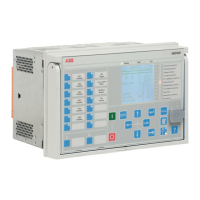8.5.1.6 Connecting jumper connectors
See the technical manual for details on jumper connectors.
8.5.1.7 Communication checklist
1. Check the physical connections.
2. After the settings are changed, allow them to be stored in the non-volatile memory
(S character on the icon area of the LHMI).
Reboot the unit to allow the setting changes to take effect in DNP3.
3. If the WHMI connection is missing, enable the protection relay's WHMI setting and
prevent the Web browser from attempting to use a proxy via Internet Options/
Connections/LAN Settings/Advanced/Exceptions (for example 192.168.*.*;).
4. Ping the unit.
Verify that the protection relay has been correctly configured to accept messages
with the master's IP address, DNP3 address, and so on.
5. Use the LHMI to enable the WHMI configuration if a ping response is received from
the unit but the WHMI does not respond.
5.1. Clear the browser of cached pages.
5.2. Logout and log back in.
6. Install a TCP packet sniffer to see what is happening on the network.
7. Clear the ARP table.
8. See the protection relay's technical manual to determine if the jumpers on the
communication board are correct.
If this protocol does not operate as expected, check that other serial
protocols are not using the COM port also.
DNP3 protocol ignores any parity setting in the COM settings group;
DNP3 is defined as an 8 bit/no parity protocol with a 16-bit CRC every 16
bytes. This provides better error detection than parity.
1MAC456939-IB D Section 8
Commissioning
620 series ANSI 127
Operation Manual

